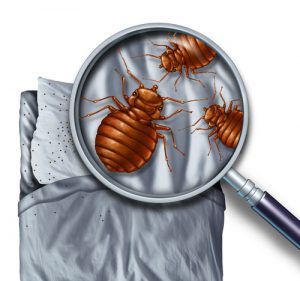Bed Bugs in Dorms
By Chris Williams on September 13, 2011.
Q. My daughter just moved into her college dorm room and is worried about getting bed bugs. There’s a rumor that one room on her floor already had to be treated for bed bugs. Is there anything she and her roommate can do to avoid getting bed bugs?
A. Yes, there are definitely steps she can take. Mainly she should be vigilant and know how to check for bed bugs. There are plenty of YouTube videos and web sites that show the bugs up close and explain how to check your bed and belongings. Secondly, she should keep in mind that bed bugs are notorious hitchhikers and can be carried from an infested site into her room on backpacks, furniture, tote bags, clothing, purses, etc.
 One of the prime ways that bed bugs spread around the country is when college students come home for vacations and summer break. Students bring bed bugs home from school, or bring them from home to school in the fall. Bed bug outbreaks in dormitories are most common after students return in the fall, but the actual incidence of bed bugs in dormitories is not as common as the media would have us believe. Your daughter should be cautious but not anxious about bed bugs. Once you have an established infestation of bed bugs, they can be extremely difficult to get rid of, but if you’re careful you shouldn’t get them. The recommendations below also apply to students living in off-campus housing or group homes:
One of the prime ways that bed bugs spread around the country is when college students come home for vacations and summer break. Students bring bed bugs home from school, or bring them from home to school in the fall. Bed bug outbreaks in dormitories are most common after students return in the fall, but the actual incidence of bed bugs in dormitories is not as common as the media would have us believe. Your daughter should be cautious but not anxious about bed bugs. Once you have an established infestation of bed bugs, they can be extremely difficult to get rid of, but if you’re careful you shouldn’t get them. The recommendations below also apply to students living in off-campus housing or group homes:
· Don’t pick up used furniture or appliances from thrift shops or from other students. And, especially, don’t bring in used beds, futons, or mattresses. Some dormitories no longer allow students to bring in their own furniture. If either your daughter or her roommate bring their own furniture, check it for bed bugs that could be hidden in cracks and crevices.
· Buy bed bug-proof covers for the mattresses and box springs. These bed bug encasements are special, zipped covers that completely cover the mattress and box spring, containing any existing bed bugs and preventing others from hiding in the bed. The bed bug encasements must be “bite proof” and “escape proof.” Some dorms provide these mattress encasements. If not, they can be ordered on the Internet; there are several brands available.
· Change bed linens weekly if possible. Periodically wash or change blankets or comforters, bed skirts, and throw pillows as well. Make sure that bedspreads and bed skirts don’t touch the floor. Pull the bed itself away from the wall. Vacuum the floor, chairs, and sofas frequently.
· Keep the dormitory room floor free of clutter. This helps eliminate bed bug hiding places and makes vacuuming easier. Bed bugs hide in all kinds of things, including clothes on the floor. Hang jackets, back packs, and purses on hooks or hangers. Try to keep the closet floor clear as well. Avoid stacking clothes and items on the bed, too.
· If you daughter feels she might have picked up bed bugs on her clothes or belongings from an infested site, she can use a clothes dryer for insurance. Fortunately, bed bugs are susceptible to high temperatures and can be killed in a standard clothes dryer. She should dry clothes, shoes, or other dryable items on high for at least 20 minutes to kill all stages of bed bugs.
If your daughter or roommate are bitten or see any signs of bed bug infestation, they must report it to the resident advisor or other dorm authority for inspection and treatment. If their room must be treated, they will probably be asked to prepare by removing items and bagging clothes. If there is a confirmed incidence of bed bugs elsewhere in the dormitory, college staff will have further information and instructions for residents affected.